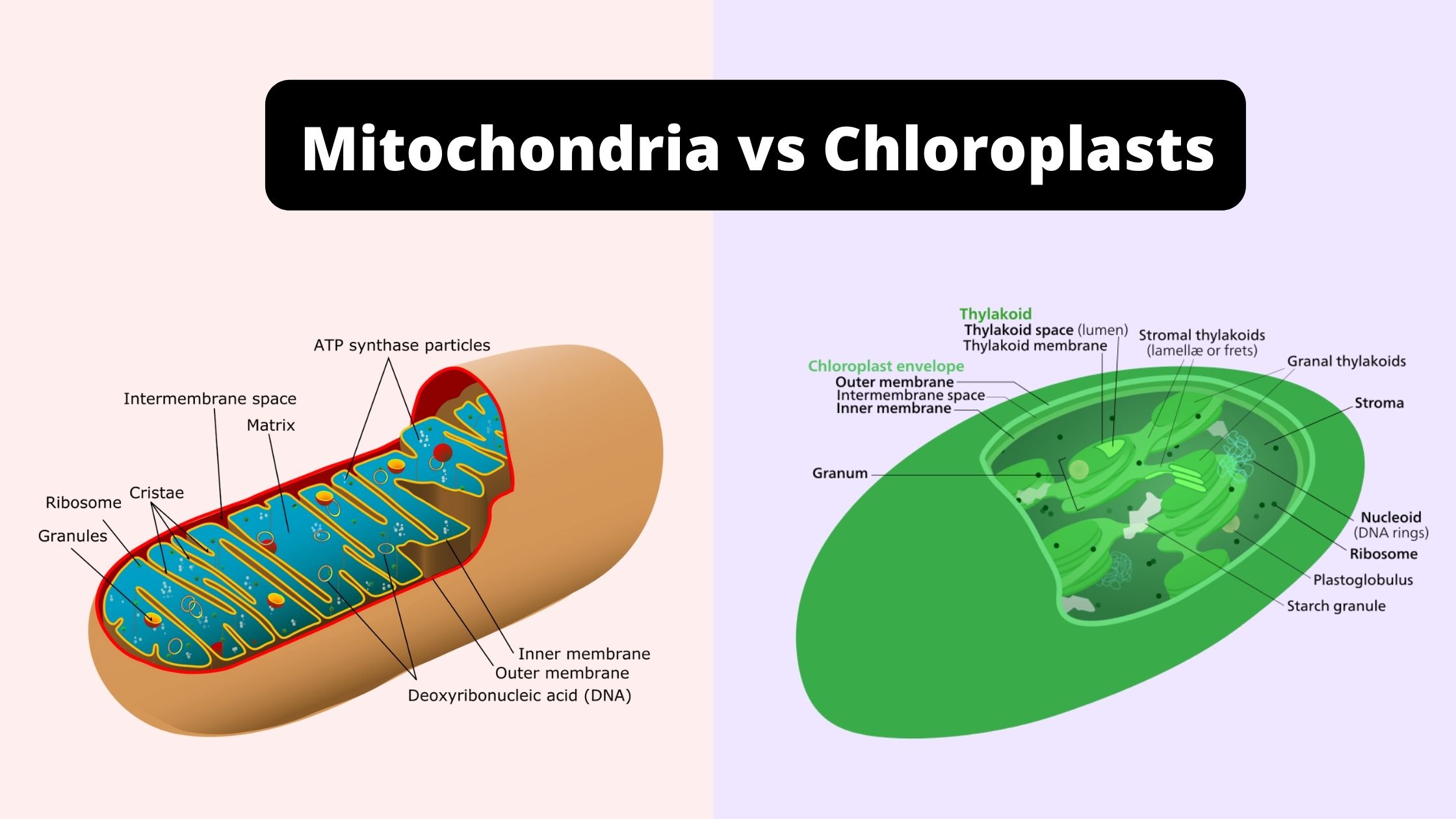Mitochondria and Chloroplast Are Two Types of
The two types of cellular power stations are organelles called chloroplasts mitochondria. One mitochondrial type is found in.

Mitochondria Vs Chloroplast Diffzi
They use these organelles to separate the functions of these two organisms within cells.

. Ribosomes and cell membrane c. Chloroplasts are responsible for the production of sugars with the aid of sunlight in a process called photosynthesis whereas mitochondria are. What is the similarity between mitochondria and chloroplast.
Difference between Mitochondria and Chloroplast is based on Presence Size Shape Colour Membrane and various other parameters. The size of bacteria is commonly 01-10 micrometers while the size of mitochondria and chloroplast is 05-10 micrometers and 1- 10 micrometers respectively. We also know that mitochondria and chloroplasts have DNA and ribosomes just as bacteria do.
In cytoplasm the energy is captured and used to produce ATP by substrate level phosphorylation during glycolysis. MBIO VOLUME 11 NUMBER 330 JUNE. For example mitochondria are the powerhouses of cells and produce most of the cells energy ATP.
There are four basic types of mitochondria. They also play an important role in other cellular functions including cell division cell signaling and even. However chloroplast is absent in an animal but mitochondria is found in both.
Mitochondria generates energy for the cell in the form of ATP using oxygen and nutrients. However chloroplast is absent in an animal but mitochondria is found in both. In fact they are the cellular generators of eukaryotic cells.
Mitochondria and chloroplast are the same in size as bacteria. In chloroplasts the energy is captured and used to produce. Mitochondria is found both in animal and in plant cells whereas chloroplast is found only in plant cells.
Mitochondria and chloroplasts are two types of quizlet. Each type is distinguished by if or how ATP is produced. The double-layered cell organelles present in a eukaryotic cell are nucleus mitochondria and chloroplast.
How Are Mitochondria And Chloroplasts DifferentThe main difference between chloroplast and mitochondria is their functions. Mitochondria and chloroplasts are two types of What are two common characteristics of mitochondria and chloroplasts. Mitochondria and chloroplast are semiautonomous organelles that share various structural similarities but the major difference is their occurrence.
Chloroplast is the site for photosynthesis in a plant cell. Mitochondria and chloroplast are organelles found in a plant cell. Do chloroplasts have mitochondria.
How are mitochondria and chloroplasts similar and different. Both mitochondria and chloroplast are two large organelles found in eukaryotic cells. A large membrane-bound bean-shaped organelle found in almost all kind of eukaryotic organism also known as powerhouse of the cell.
Mitochondria and chloroplast play an important role in the building functioning and growth of the cell. Let us discuss the difference between mitochondria and chloroplast in detail. The basic proteins involved in the formation of.
Mitochondria and chloroplasts are surrounded by two or more membranes like bacteria. These two organelles and symbiotic bacterial cells share some structural features such as the ability to self-replicate presence of circular DNA and similar ribosomes etc. This captured energy into smaller packets that are useful for powering cellular work.
Thus plants today contain both mitochondrial and chloroplast genomes. Mitochondria and chloroplast are semi-autonomous organelles. Mitochondria and chloroplast are organelles found in a plant cell.
The chloroplast is found only in green plants and in few algae they are the sites of photosynthesis. Mitochondria are membrane-bound organelles found in almost all eukaryotic organisms. Scientists believe that host cells and bacteria formed a mutually beneficial endosymbiotic relationship when the host cells ingested aerobic bacteria and cyanobacteria but did not.
Formed by division of pre-existing organelles and they contain DNA and protein synthesizing machinery. Mitochondria and cell wall b. For duplication they have circular double stranded DNA 70S ribosomes and different types of RNAs that is mRNA tRNA rRNA for protein synthesis.
Mitochondria are termed as the powerhouse of the cell whereas chloroplast is termed as the kitchen of the cell. It is demonstrated that plant mitochondrial and chloroplast DNAs are packaged into deoxynucleoprotein fibrils comprising nucleosome-like and nucleomere-like globules. Mitochondria and chloroplasts d.
In a eukaryotic cell energy transformation reactions majorly occur in cytoplasm mitochondria and chloroplast. A similar structure is characteristic of the subgenomic DNAs. In mitochondria the energy is captured and used to produce ATP by oxidative phosphorylation.
The fibrils form loops and rosette-like structures with central proteinaceous components. They are capable of self duplication. Mitochondria are responsible for cellular respiration and energy metabolism.
Mitochondria occur in all cells of plants and animals while chloroplast only occurs in tissues that help in photosynthesis. Mitochondria generates energy for the cell in the form of ATP using oxygen and nutrients. Which of the following cell parts have similar or related jobs.
Mitochondria are found in eukaryotic animal cells whereas chloroplasts are found in plant cells. Scientists have long noticed that bacteria mitochondria and chloroplasts are similar in size. One harnesses light energy from the sun and the other unpacks.
Because of such similarities scientists. Chloroplast is the site for photosynthesis in a plant cell.

Differences Between Mitochondria And Chloroplast Mitochondria Vs Chloroplasts

How Are Mitochondria And Chloroplasts Similar Mitochondria And Chloroplasts Similarities Lisbdnet Com
Difference Between Chloroplast And Mitochondria Structure Function Comparison
Comments
Post a Comment